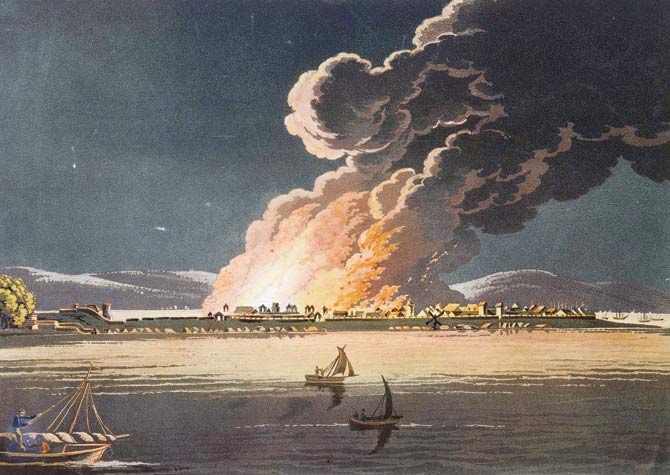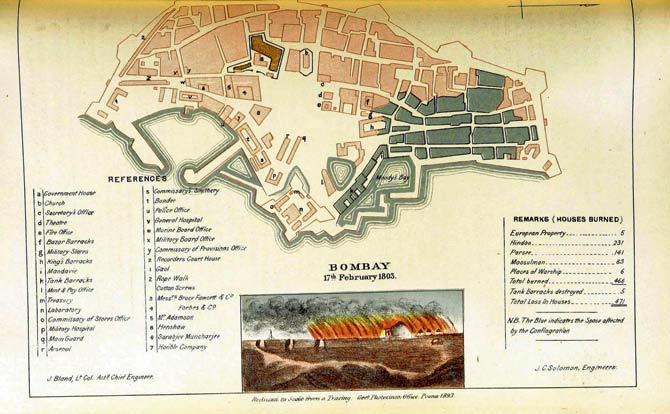Over 200 years before the Kamala Mills conflagration, another fire ravaged parts of the city, urging town planners to rethink the idea of Bombay. Journey back to the 1800s with an expert talk on the subject


Artist JSâu00c2u0080u00c2u0088Barth's portrayal of the Fort fire from Malabar Hill. Pics/wikimedia commons
ADVERTISEMENT
Two centuries ago, in a Bombay which was 50 years away from getting its first railway line, and whose seven islands were still in the process of getting stitched together, there was something it had in common with its present-day avatar: congestion. But it wasn't seen as a problem by the colonial rulers until a massive fire broke out on February 17, 1803, ravaging the Fort area and burning down 466 houses and five barracks. Such was the scale of devastation that the authorities were forced to rethink the idea of Bombay. Was it a garrison, a mercantile port or a city within a fort?

A map showing the layout of the Fort in 1803. The area in grey shows the fire-affected parts
This evening, Dr Sukriti Issar will take listeners on a journey of the early 19th-century Bombay through her masterclass on The Great Mumbai Fire of 1803. Assistant professor at Sciences Po, Paris, a leading university in social sciences, Dr Issar works in the sociology department and in the Governing the Large Metropolis masters programme. "I am really interested in the history of Bombay, its buildings and the way they are regulated. I have been researching [the subject] for more than 12 years," shares Dr Issar, who has worked in Mumbai for three years. About her interest in this episode in the city's history, she says, "There are scattered mentions of the 1803 fire in many books. For example, [it finds a mention in] SM Edwardes' The Gazetteer of Bombay City And Island. Though it is seen as one of the important events in the city, there haven't been in-depth treatments of it."
When asked about the probable cause of the fire, Dr Issar paints a picture of the Fort of the 1800s. "Around 10,800 people were reported to live within the Fort in 1814. To put it in perspective, Fort's population in 2011 was about 36,400. The grievance of every inch being built upon was common in those days, too. Both residential and commercial, the Fort was also a place for storing goods. Cotton bales, ghee, oil, and other flammable material was stored in the open," she explains, adding that many buildings were made of cadjan, a thatched roof of sorts, comprising leaves of the brab tree, which also made them prone to fires. About the casualties, she says that while no exact figures are quoted, the loss of life was said to be "small".
"Urban catastrophes like fires, floods, hurricanes, earthquakes or even terror attacks often result in immediate institutional change. Committees are set up. Decisions are taken quickly," says Dr Issar about what emerged from the fire. The authorities began to see the city as a combination of commerce and security while moving some residents out of the Fort area. This move, some reports suggest, led to the segregation of residences on the basis of communities.
"After the fire, the Town Committee (rapidly set up in 1803) suggested limiting the heights of buildings to prevent more density. This is very similar to the immediate response to the Kamala Mills tragedy where the government is rethinking the FSI policy," remarks Dr Issar.
What then went wrong with the planning, considering Mumbai remains one of the most congested cities to live in? "For a brief period the status quo is disrupted and reform can take place," she replies. "However, as the 1803 fire shows, the moment of institutional openness often passes, and the status quo returns."
On: Today, 6 pm to 7.30 pm
At: Alliance Francaise Auditorium, 40, Marine Lines
Call: 22035993
Download the new mid-day Android and iOS apps to get updates on all the latest and trending stories on the go
 Subscribe today by clicking the link and stay updated with the latest news!" Click here!
Subscribe today by clicking the link and stay updated with the latest news!" Click here!






